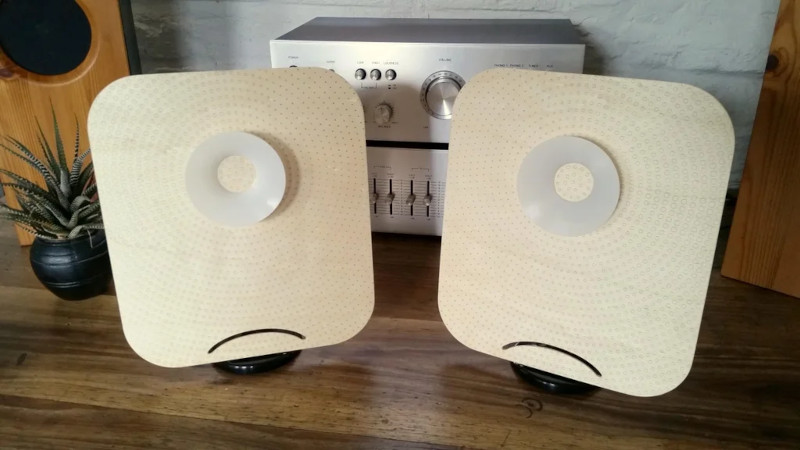Distributed-mode loudspeakers work rather differently from the typical drivers used in 99% of applications. Instead of using piston-like motion to create sound waves, they instead rely on exciting an entire panel to vibrate and thus produce sound. [JGJMatt] decided to build a pair of bookshelf-sized units, with great results.
The build begins with a pair of 44mm DML exciters, readily available online. These had to be modified to remove their stock metal mounting plates that degraded the sound output in early tests. Instead, 3D printed pieces were used to mount the exciters to the 3mm plywood boards, which were lasercut to act as the main DML panels. Additionally, whizzer cones were fitted to the panels in an effort to further boost the high frequency response of the speakers. The speaker stands are assembled out of more 3D printed pieces and aluminium rods, giving a clean, modern look to the final product.
The performance of the speakers is admirable based on the test video, though [JGJMatt] notes that they should be paired with a subwoofer in use as the DML units do not readily produce frequencies below 100Hz. We’ve seen similar builds before on a larger scale, too. Video after the break.
















A video of speakers in an undefined room playing an MP3 through an unknown amp and recording with an unknown mic and then played back through my PC with undefined characteristics. Sure, great sound. A tiny bit of analytics might be useful.
To paraphrase, there are people who enjoy reading poetry and there are people arguing whether it reads better on A4 or letter-sized paper and which brand of laser printer should be used to achieve the best looking text.
More like they are arguing whether it is better to scramble the letter order within each word but keep the first and last letter intact.
All those unknowns could have been avoided by connecting the mp3 player directly up to the sound card line in when recording the video.
Good point. Still wouldn’t address the fact that my PC speakers aren’t great. I have a 24-bit DAC with headphone driver. He could email the MP3 and I could play it on my Grados. I bet his speakers would sound pretty good that way except for the MP3 issue. I could maybe hire a band . . .
Not sure if this builder has seen (or referenced) TechIngredients but he’s one of the all time favorite tech youtubers. If you want data and theory in an easy to digest format, he’s your man. Here’s the post on this type of speaker: https://youtu.be/zdkyGDqU7xA
Looks like HaD has run one of his videos on this topic a little over a year ago: https://hackaday.com/2019/10/26/building-the-worlds-best-dml-speakers-for-under-115/
Definitely my N.1 Youtube channel in theory, design, testing, quantization and evaluation of results
Fifty years ago, there were styrofoam panel speakers that were similar to these panel speakers. They were pretty cheap, flat, and waterproof. Plywood panels would be sturdier.
used to have some styrofoam speakers like that many moons ago..
I wonder if using differnt timbers for the panel would have different acoustic response – like different timbers effect the sound of a guitar?
Was just skimming through old mags yesterday and saw a mention of styrofoam and speakers. In that it recommended sealing the surface with a PVA type glue or else “it lets the bass right through” … no idea if author was talking crap or not, I know some foam boards are a bit air porous.
I have messed around with Distributed Mode Loudspeakers (DMLs), they can turn out great, but smaller panels will need a traditional bass radiator. An equalizer is mandatory (hint, use an old laptop or PC and a fairly good USB sound dongle) as is a reference mic (Behringer/Sonarworks/Dayton Audio/PreSonus typ. ~$80-$100) and some way to calibrate the measurement setup (yeah, chicken and egg problem). Here’s another nice article on a simple homebrew DML:
http://projectgallery.parts-express.com/speaker-projects/dml-flat-pannel/
Those are a couple of sad speakers.
I get it.
Not everybody appreciates humor.
:
Speaker “tests” without numbers? Without graphs of frequency response and directionality? Without value.
Also neglected to use 6 gauge speaker cables so they don’t lose a tenth of a decibel at 20khz on a 100ft run.
In the end it is a project – and an interesting one. I would have liked to hear the good old TAKE FIVE to get a feeling and compare. The additional Bass Reflex Boxes on my Laptop seem to indicate, that some transparancy is missing, but here you would have to compare with the direct output of this track. Is there a link ? We compared speakers and amplifiers many moons ago, over a couple of beers, and our ear was always good enough to measure and we agreed in most cases. No numbers needed, Ok we had the manufacturer’s data as indicator. In the end it is personal taste anyway.
Judging by the video these are nice novelty speakers, but they sound tinny and scratchy, and there are some obvious resonances that turn into heavy distortion on particular frequencies. Basically sounds a bit like a cheap plastic speaker with a snap-fit element that is buzzing against the panel.